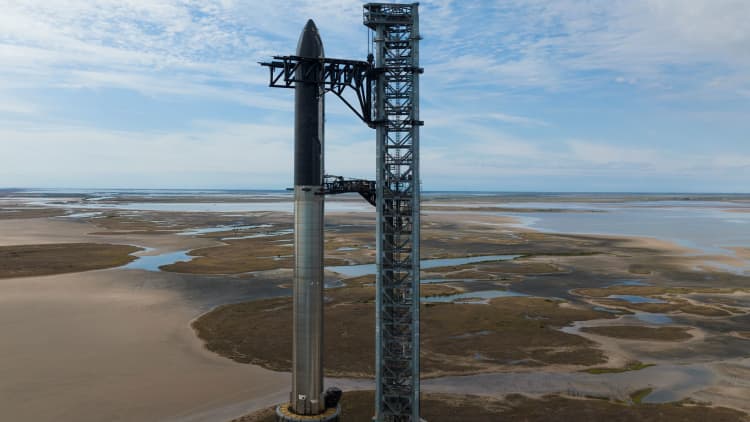
A Starship prototype is seen stacked on top of a Super Heavy booster at the company’s launch facility near Brownsville, Texas.
SpaceX
The Federal Aviation Administration issued a Starship launch license to Elon Musk’s SpaceX, a crucial final regulatory step that clears the company to attempt an orbital launch of its towering rocket for the first time.
“After a comprehensive license evaluation process, the FAA determined SpaceX met all safety, environmental, policy, payload, airspace integration and financial responsibility requirements. The license is valid for five years,” FAA said in a statement.
SpaceX, with the FAA license now in hand, aims to launch Starship as soon as Monday from its private facility in Texas along the Gulf Coast.
“SpaceX is targeting as soon as Monday, April 17 for the first flight test of a fully integrated Starship and Super Heavy rocket from Starbase in Texas. The 150-minute test window will open at 7: 00 a.m. CT,” SpaceX said in a statement.
The company recently stacked Starship prototype 24 on Super Heavy booster prototype 7 in preparation for the launch. Together they stand nearly 400 feet high. SpaceX in February completed a test firing of the Super Heavy booster, which has 33 Raptor engines at its base, in one of the final technical steps toward the launch.
SpaceX for several years has been building up to the first orbital flight test of its Starship rocket, with company leadership stressing the experimental nature of the launch. While SpaceX had hoped to conduct the first orbital Starship launch as early as summer 2021, delays in progress and regulatory approval have pushed back that timeline.
The rocket is set to lift off from SpaceX’s development facility near Brownsville, Texas, before heading east across the Gulf of Mexico, according to 2021 filings that revealed the flight plan. The ultimate goal of the mission is to reach orbit, with the rocket aiming to travel most of the way around the Earth and splash down in the Pacific Ocean off the coast of Kauai, Hawaii.
Starship is designed to carry cargo and people beyond Earth and is critical to NASA’s plan to return astronauts to the moon. SpaceX won a nearly $3 billion contract from the space agency in 2021 to use Starship as a crewed lunar lander.
